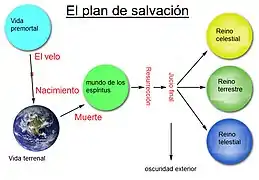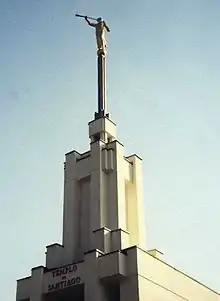The Church of Jesus Christ of Latter-day Saints in Chile
As of December 31, 2018, The Church of Jesus Christ of Latter-day Saints (LDS Church) reported 595,526 members in 77 stakes and 16 districts, 590 congregations (430 wards[1] and 160 branches),[1] ten missions, and two temples in Chile.[2]
| Year | Members | ±% |
|---|---|---|
| 2011 | 563,689 | — |
| 2012 | 577,716 | +2.5% |
| 2013 | 583,359 | +1.0% |
| 2014 | 579,235 | −0.7% |
| 2015 | 581,155 | +0.3% |
| 2016 | 585,887 | +0.8% |
| 2017 | 590,124 | +0.7% |
| 2018 | 595,526 | +0.9% |
| 2019 | 602,373 | +1.1% |
| Source: https://newsroom.churchofjesuschrist.org/facts-and-statistics/country/chile | ||
History

The LDS Church has been established in Chile for over sixty years. The church experienced some periods of rapid expansion during that time, becoming, by some estimates, the second largest church in the country.
Early apostle Parley P. Pratt was among the first Mormon missionaries to preach in Chile, landing in Valparaiso in November, 1851, along with Elder Rufus Allen and Phoebe Sopher, one of Pratt's wives, who was pregnant at the time. The mission party was impressed by the Chilean countryside and people. Pratt wrote that the people he met in Chile were "a neat, plain, loving and sociable people; very friendly, frank, and easy to become acquainted with," but the mission trip met with tragedy when the Pratt's month-old son died in January 1852.[3] Hampered by language difficulties and a lack of literature in the Spanish language (selections of the Book of Mormon were not translated into Spanish until 1875)[4] the missionaries left Chile after four months without having a successful baptism.[3] Pratt used his experience in South America to advise Brigham Young that the success of future missionary efforts would be based on translations of the Mormon scriptures.[5] Another difficulty was that, at the time of Pratt's visit, the Chilean constitution did not permit the practice of any religion besides Catholicism.[6]
Missionary work in Chile began in earnest in 1956, when the country was made part of the Argentine mission and the first small branch was formed.[7] By 1961, the country had 1,100 members and the Chilean mission was organized. The following three decades saw explosive growth in church membership, with the church membership doubling every two years at its peak.[3] The growth sparked a building boom during these decades. Hundreds of LDS meetinghouses were constructed, capped by the dedication of the Santiago Temple in 1983. Church growth continued in the 1990s, with the country having the greatest growth in LDS membership in South America during the decade. Between 1994 and 1996, 26 new stakes were dedicated in the country.[7]
The period of rapid expansion in membership was followed by a sharp contraction. The church is now retrenching after its period of high growth and hundreds of units have been decommissioned since 1998.[8] In 2002, the church sent Elder Jeffrey R. Holland, a member of the Quorum of the Twelve Apostles, to remain in Chile for a year to train leadership and minister to the church,[9] a role typically held by members of the quorums of the seventy. Due to high levels of member inactivity, 37% of the stakes created in Chile have since been discontinued.[10]
Although an average of 12,000 people were baptized annually between 1961 and 1990, membership growth has now cooled and the church has a large number of inactive members. According to census data, 0.9% of the population claims to be Mormon, based upon those aged 15 and over who identify themselves as Mormon. The church itself reports that it has 595,526 members in Chile, which is equal to about 3.3% of the population. If accurate, these numbers makes the LDS Church the single largest denomination in Chile after Catholicism.[11] LDS statistics counts everyone baptized, including children age eight or older as well as inactive members. Using unofficial sources, the Cumorah Project website estimates that 20% of Chilean members actively attend church services.[8]
Jorge F. Zeballos, a former civil engineer, is a Chilean-born LDS general authority. He was called to the First Quorum of the Seventy in April, 2008.[12] Zeballos is the second Chilean to serve as a general authority. He followed Eduardo Ayala, who served in the Second Quorum of the Seventy from 1990 to 1995.
A second temple, in Concepción, was announced in 2009. The groundbreaking for this temple occurred on October 17, 2015,[13] and it was later dedicated on October 28, 2018.[14]
In April 2019, church president Russell M. Nelson announced a third Chilean temple to be built in Antofagasta.[15]
In 2020, the LDS Church canceled services and other public gatherings indefinitely in response to the spread of the coronavirus pandemic.[16]
Church schools in Chile
When the Chilean Mission was organized in 1961, A. Delbert Palmer was its mission president.[17]:99–100 Church leaders considered communism to be an "evil force" and area authority Theodore Tuttle encouraged Palmer to create a school to protect students from communism.[17]:101 Local members requested schooling for their children, especially after some were expelled from Catholic schools for joining the LDS Church.[17]:102 In 1963, Tuttle and Palmer started preparing two elementary schools in La Cisterna and Vina del Mar. They reported directly to the first presidency rather than to the CES board of education. Dale Harding's position as superintendent was both a professional and religious position.[17]:103 The schools opened in March 1964.[17]:106
In the 1960s in Chile, educational reforms gave children more opportunities for education, but there still existed a large divide between public and private schools, both of which were supported by the government. Because of the educational situation, parents were very interested in private LDS schools for their children.[17]:108–109 After the first year, all the children passed their government-administered end-of-year exams, with many performing very well.[17]:110–111 A large earthquake in March 1965 greatly damaged both schools, but the schools continued despite this setback. Rather than use the traditional lecture-exam format, teachers varied their teaching methods to include group work and in-service training.[17]:111–112 In 1967, Lyle J. Loosle became the new superintendent. Under his leadership, volunteers supported new elementary schools in Nunoa and Talcahuano.[17]:114–115
In 1970, the Church Board of Education approved the purchase of a Catholic school near Santiago.[17]:117 Later that year, Salvador Allende, a Marxist, was elected as president, and Church members were uncertain about the future of the LDS Church and Church schools.[17]:118 Middle-class citizens of various kinds opposed a National Unified School system. The minister of education requested using a church building for another session of schooling.[17]:120 In response, Loosle increased enrollment to ensure that the schools were always operating at full capacity. Kindergartens operated in LDS chapels in Arica, Inquique, and La Calera to keep them from being used by the government for other purposes.[17]:121 After Allende was overthrown, the kindergartens closed.[17]:129
Seminary teacher Richard Brimhall visited the schools in 1972 and felt alarmed at how many faculty were Marxists. That year, Jorge Rojas, from Mexico, became the next superintendent. He felt that the Church schools ought to be closed because of their Marxist leanings, and made this recommendation to Church officials.[17]:123 After Rojas dismissed two non-member teachers, other teachers formed a union to protest new policies. Loosle was asked to return after Church headquarters reassigned Rojas to a school in Mexico. Loosle dismissed teacher's union leaders when they refused to resign.[17]:124 The union leaders demanded reinstatement.[17]:125 Loosle asked teachers to repent of their unionization; some union members left the school, while others left the union. Loosle rehired some of the union leaders.[17]:125 In 1973, Beningno Pantoja Arratia became the new superintendent, and he instituted several reforms, including ecclesiastical interviews.[17]:129 In 1970, Neal A. Maxwell became the Church Commissioner of Education, a new position overseeing Church schools, seminaries, and institutes.[17]:129 A 1971 policy from Maxwell stated that non-religious education should only be provided by the Church when "other educational systems are nonexistent, seriously deficient or inaccessible to our members."[17]:130 Chilean church schools started to close in 1977, with the Church's growth and adequate public schools given as reasons for closure.[17]:130 By 1981, Church schools had completely closed in Chile, Peru, Bolivia, and Paraguay.[17]:131
Missions
- Chile Antofagasta Mission
- Chile Concepción Mission
- Chile Concepción South Mission
- Chile Osorno Mission
- Chile Rancagua Mission
- Chile Santiago East Mission
- Chile Santiago North Mission
- Chile Santiago South Mission
- Chile Santiago West Mission
- Chile Viña del Mar Mission
Temples
Red = Operating
Blue = Under Construction
Yellow = announced
Black = Closed for Renovations
|
|
24. Santiago Chile Temple | ||
|
Location: |
Santiago, Chile | ||
| 160. Concepción Chile Temple | |||
|
Location: |
Concepción, Chile | ||
| 199. Antofagasta Chile (Under Construction) | |||
|
Location: |
Antofagasta, Chile | ||
See also
Notes
- LDS Meetinghouse Locator.Nearby Congregations (Wards and Branches).
- "LDS Statistics and Church Facts - Total Church Membership". Retrieved 11 September 2018.
- "The Biggest Little Mormon Country in the World - VQR Online". www.vqronline.org. Retrieved 11 September 2018.
- Stocks, Hugh G. (1992), "Book of Mormon Translations", in Ludlow, Daniel H (ed.), Encyclopedia of Mormonism, New York: Macmillan Publishing, pp. 213–214, ISBN 978-0-02-879602-4, OCLC 24502140
- | Autobiography of Parley P. Pratt.
- "Chile: Virtual Jewish History tour". Jewish Virtual Library. Retrieved August 11, 2013.
- "Chile". newsroom.lds.org. Archived from the original on 2010-06-18. Retrieved 2010-06-28.
- "International Resources for Latter-day Saints". Retrieved 11 September 2018.
- "Country information: Chile". 28 January 2010. Retrieved 11 September 2018.
- Martinich, Matt. "Discontinued Stakes Worldwide". Retrieved 28 August 2016.
- "LDS News - Mormon News - Official Newsroom of the Church". www.mormonnewsroom.org. Archived from the original on 1 October 2007. Retrieved 11 September 2018.
- "LDS Church News - A Living Record of the Restoration". LDS Church News. Archived from the original on 15 May 2014. Retrieved 11 September 2018.
- Swenson, Jason. "Ground broken for future temple in Concepción". thechurchnews.com. Deseret News. Retrieved 17 April 2019.
- Weaver, Sarah Jane. "President Nelson calls Chile temple dedication 'heavenly crescendo' for 5-nation tour". Deseret News. Deseret News. Retrieved 17 April 2019.
- "Prophet Announces Eight New Temples at April 2019 General Conference". Mormon Newsroom. The Church of Jesus Christ of Latter-day Saints.
- Lovett, Ian. "Mormon Church Cancels Services World-Wide Amid Coronavirus Crisis", The Wall Street Journal, 12 March 2020. Retrieved on 3 April 2020.
- Griffiths, Casey Paul; Esplin, Scott C. (2014). ""Colegias Chilenes de los Santos de los Ultimos Dias": The History of Latter-day Saint Schools in Chile". Journal of Mormon History. 40 (1): 97–134.
- "President Thomas S. Monson: 'Welcome to Conference'", Deseret News, October 3, 2009, retrieved 2012-11-06.
- Talor, Scott (October 4, 2009), "Brigham City among five new locales for LDS temples", Deseret News, retrieved 2012-11-06.
- "Prophet Announces Eight New Temples at April 2019 General Conference", Newsroom, LDS Church, 7 April 2019
References
- Néstor Curbelo, "Conversion and Change in Chile", Liahona, October 2014
External links
- LDS Newsroom - Chile
- The Church of Jesus Christ of Latter-day Saints (Chile) - Official Site
- The Church of Jesus Christ of Latter-day Saints - Visitors Site


